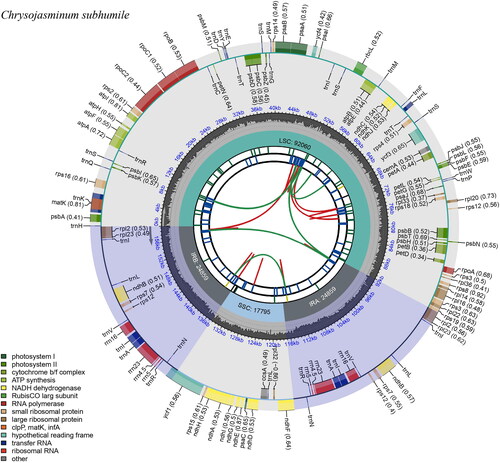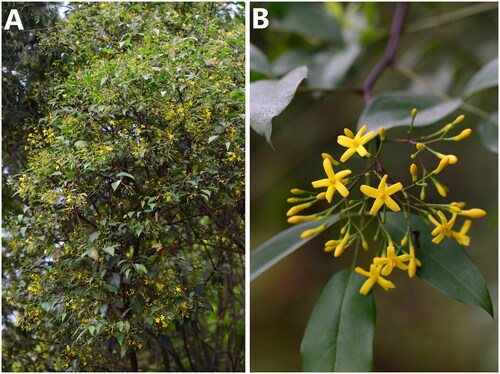Abstract
We assembled and characterized the complete chloroplast genome sequence of Chrysojasminum subhumile (W.W.Sm.) Banfi & Galasso 2014, a valuable horticultural and medicinal plant species. The total genome size was 159,918 bp in length and the GC content was 37.4%. It displayed a circular structure and could be divided into a large single-copy region, a small single-copy region, and a pair of inverted repeat regions. The genome encoded a total of 131 unique genes, including 82 protein-coding genes, 41 tRNA genes, and eight rRNA genes. Among these genes, 17 contained a single intron, and two genes had two introns. Phylogenetic analysis results showed that C. subhumile was closely related to Jasminum.
1. Introduction
Chrysojasminum is a genus of flowering plants in the family Oleaceae and order Lamiales. Oleaceae plants are widely distributed in tropical and temperate regions of both hemispheres, with a particularly rich variety in Asia. The Oleaceae family has many important medicinal plants, spice plants, oil plants, and economic tree species. Chrysojasminum was established to revise the generic delimitation of jasmine (Banfi Citation2014), since those species possessing both alternate leaves and yellow flowers constitute a monophyletic group that is sister to all other jasmine plus the American/South African genus Menodora (Lee et al. Citation2007; Kim and Kim Citation2011).
The chloroplast is a crucial organelle for photosynthesis, as well as vitamin, starch, protein, and pigment synthesis. Chloroplast genes are generally matrilineal in angiosperms, with only a few species exhibiting biparental or paternal inheritance (Hu Citation2008). As the chloroplast genome is the smallest genome in plant cells, with easily accessible full sequences, modest evolution rate, and conserved gene composition, it has become an ideal model for evolutionary and phylogenetical studies (Shaw et al. Citation2007; Mehmood et al. Citation2020a, Citation2020b, Citation2020c). As a consequence, the Chrysojasminum genomic data are required to examine its phylogenetic position within jasmine. In this experiment, we published the first comprehensive plastome report for Chrysojasminum subhumile (W.W.Sm.) Banfi & Galasso, a common ornamental and medicinal plant () (Chang et al. Citation1996). The annotated genomic sequence has been deposited in GenBank as registration number OK236384.
2. Materials and methods
Plant samples were collected from Kunming Institute of Botany, Kunming, China (E102.7515°, N25.1411°). Voucher herbarium specimens (zhu20200702) were stored in Guizhou Normal University’s Department of Botany (Xingfu Zhu, email: [email protected]). Using the Qiagen DNeasy Plant Mini Kit (Qiagen, Carlsbad, CA), we extracted the whole DNA from one C. subhumile sample, and then we carried out the subsequent high-throughput sequencing on an Illumina Hiseq 2500 System. The raw data after filtered with Trimmomatic 0.38 (Bolger et al. Citation2014) were delivered to the GetOrganelle program (Jin et al. Citation2020) to build the whole chloroplast genome, the usage parameters are: -R 15 -k 21,45,65,85,105 -F embplant_pt. The CPGview (Liu et al. Citation2023) and PGA software (Qu et al. Citation2019) were used to perform the genome annotation with default parameter.
3. Results and discussion
3.1. Genome compositions
The chloroplast genome of C. subhumile has a typical cyclic tetrad structure, which consists of a pair of 23,022 bp repetitive sequences and two single copy regions with 95,780 bp and 17,794 bp, respectively (). It encodes 131 distinct genes in total, 13 of which are duplicated in the IR areas. It has eight rRNA genes, 41 tRNA genes, and 82 protein-coding genes. In addition, 11 genes only contain one intron, while one gene (ycf1) has five intros and one gene (ycf3) has two introns.
Figure 2. Graphic representation of features identified in Chrysojasminum subhumile chloroplast genome using cpgview (http://www.1kmpg.cn/cpgview). The map contains six rings. From the center outward, the first track shows the dispersed repeats. The dispersed repeats consist of direct (D) and Palindromic (P) repeats, connected with red and green arcs. The second track shows the long tandem repeats as short blue bars. The third track shows the short tandem repeats or microsatellite sequences as short bars with different colors. The colors, the type of repeat they represent, and the description of the repeat types are as follows. Black: c (complex repeat); green: p1 (repeat unit size = 1); yellow: p2 (repeat unit size = 2); purple: p3 (repeat unit size = 3); blue: p4 (repeat unit size = 4); orange: p5 (repeat unit size = 5); red: p6 (repeat unit size = 6). The small single-copy (SSC), inverted repeat (IRa and IRb), and large single-copy (LSC) regions are shown on the fourth track. The GC content along the genome is plotted on the fifth track. The base frequency at each site along the genome will be shown between the fourth and fifth tracks. The genes are shown on the sixth track. The optional codon usage bias is displayed in the parenthesis after the gene name. Genes are color-coded by their functional classification. The transcription directions for the inner and outer genes are clockwise and anticlockwise, respectively. The functional classification of the genes is shown in the bottom left corner.

3.2. Comparative analysis of chloroplast genomes
In order to determine the phylogenetic position of C. subhumile, six complete chloroplast genomes of Jasminum were obtained from the GenBank. In addition, Fontanesia phillyreoides and Ligustrum quihoui of Oleaceae family were taken as outgroups. Seventy chloroplast protein-coding genes were extracted from the nine complete chloroplast sequences, and then they were compared by MAFFT 7th edition software (Katoh and Standley Citation2013). The phylogenetic analysis was performed on the maximum-likelihood analysis of RAxML under the general time reversible nucleotide substitution model with the gamma model of rate heterogeneity (Alexandros Citation2014). The findings are consistent with previous researches that the phylogenetic analysis strongly supported C. subhumile as a sister species of Jasminum (Lee et al. Citation2007; Kim and Kim Citation2011) (). The sequenced chloroplast genome of C. subhumile will be an important genetic resource for further research on the genetic diversity and conservation of jasmine plants.
Figure 3. Phylogenetic relationships among nine complete chloroplast genomes of Oleaceae. The newly reported genome of Chrysojasminum subhumile was represented in red. Fontanesia phillyreoides and Ligustrum quihoui of Oleaceae family were taken as outgroups. Bootstrap support values are given at the nodes and the GenBank accession number was listed after the species name.

Author contributions
Xinyu Ling and Xingfu Zhu were involved in the conception and design. Xinyu Ling and Rui Liao participated in the analysis and interpretation of the data. Xinyu Ling drafted the paper and Rui Liao revised it critically for intellectual content. The version to be released is finally approved by Xingfu Zhu. All authors agree to be accountable for all aspects of the work.
Ethics statement
Chrysojasminum subhumile was not listed as a national and provincial key protected wild plant in China nor a threatened species on the IUCN Red List. Therefore, no specific permissions or licenses were needed for the sampling of C. subhumile for research purpose according to the regulations of the People’s Republic of China on the protection of wild plants. During the sampling process, we followed the local sampling guideline to ensure no substantial harm to the collecting individual.
Supplemental Material
Download JPEG Image (259.8 KB)Supplemental Material
Download JPEG Image (82.5 KB)Supplemental Material
Download Text (3.7 KB)Supplemental Material
Download JPEG Image (1.4 MB)Disclosure statement
No potential conflict of interest was reported by the author(s).
Data availability statement
The genome sequence data that support the findings of this study are openly available in GenBank of NCBI at https://www.ncbi.nlm.nih.gov/ under the number OK236384. The associated BioProject, SRA, and Bio-Sample numbers are PRJNA842199, SRR19448979, and SAMN28649230, respectively.
Additional information
Funding
References
- Alexandros S. 2014. Raxml version 8: a tool for phylogenetic analysis and post-analysis of large phylogenies. Bioinformatics. 9:1312–1313.
- Banfi E. 2014. Chrysojasminum, a new genus for Jasminum sect. Alternifolia (Oleaceae, Jasmineae). Nat Hist Sci. 1(1):3–6. doi: 10.4081/nhs.2014.54.
- Bolger AM, Marc L, Bjoern U. 2014. Trimmomatic: a flexible trimmer for Illumina sequence data. Bioinformatics. 30(15):2114–2120. doi: 10.1093/bioinformatics/btu170.
- Chang MC, Qiu LQ, Green PS. 1996. Oleaceae. Flora China. 15:272–319.
- Hu Y, Zhang Q, Rao G, Sodmergen . 2008. Occurrence of plastids in the sperm cells of Caprifoliaceae: biparental plastid inheritance in angiosperms is unilaterally derived from maternal inheritance. Plant Cell Physiol. 49(6):958–968. doi: 10.1093/pcp/pcn069.
- Jin JJ, Yu WB, Yang JB, Song Y, dePamphilis CW, Yi TS, Li DZ. 2020. GetOrganelle: a fast and versatile toolkit for accurate de novo assembly of organelle genomes. Genome Biol. 21(1):241. doi: 10.1186/s13059-020-02154-5.
- Katoh K, Standley DM. 2013. MAFFT multiple sequence alignment software version 7: improvements in performance and usability. Mol Biol Evol. 30(4):772–780. doi: 10.1093/molbev/mst010.
- Kim DK, Kim JH. 2011. Molecular phylogeny of tribe Forsythieae (Oleaceae) based on nuclear ribosomal DNA internal transcribed spacers and plastid DNA trnL-F and matK gene sequences. J Plant Res. 124(3):339–347. doi: 10.1007/s10265-010-0383-9.
- Lee HL, Jansen RK, Chumley TW, Kim KJ. 2007. Gene relocations within chloroplast genomes of Jasminum and Menodora (Oleaceae) are due to multiple, overlapping inversions. Mol Biol Evol. 24(5):1161–1180. doi: 10.1093/molbev/msm036.
- Liu S, Ni Y, Li J, Zhang X, Yang H, Chen H, Liu C. 2023. CPGView: a package for visualizing detailed chloroplast genome structures. Mol Ecol Resour. 23(3):694–704. doi: 10.1111/1755-0998.13729.
- Mehmood F, Abdullah , Shahzadi I, Ahmed I, Waheed MT, Mirza B. 2020a. Characterization of Withania somnifera chloroplast genome and its comparison with other selected species of Solanaceae. Genomics, 112(2):1522–1530. doi: 10.1016/j.ygeno.2019.08.024.
- Mehmood F, Abdullah , Ubaid Z, Bao Y, Poczai P, Mirza B. 2020b. Comparative plastomics of Ashwagandha (Withania, Solanaceae) and identification of mutational hotspots for barcoding medicinal plants. Plants. 9(6):752. doi: 10.3390/plants9060752.
- Mehmood F, Abdullah , Ubaid Z, Shahzadi I, Ahmed I, Waheed MT, Poczai P, Mirza B. 2020c. Plastid genomics of Nicotiana (Solanaceae): insights into molecular evolution, positive selection and the origin of the maternal genome of Aztec tobacco (Nicotiana rustica). PeerJ. 8:e9552. doi: 10.7717/peerj.9552.
- Qu XJ, Moore MJ, Li DZ, Yi TS. 2019. PGA: a software package for rapid, accurate, and flexible batch annotation of plastomes. Plant Methods. 15(1):1–12. doi: 10.1186/s13007-019-0435-7.
- Shaw J, Lickey EB, Schilling EE, Small RL. 2007. Comparison of whole chloroplast genome sequences to choose noncoding regions for phylogenetic studies in angiosperms: the tortoise and the hare III. Am J Bot. 94(3):275–288. doi: 10.3732/ajb.94.3.275.

